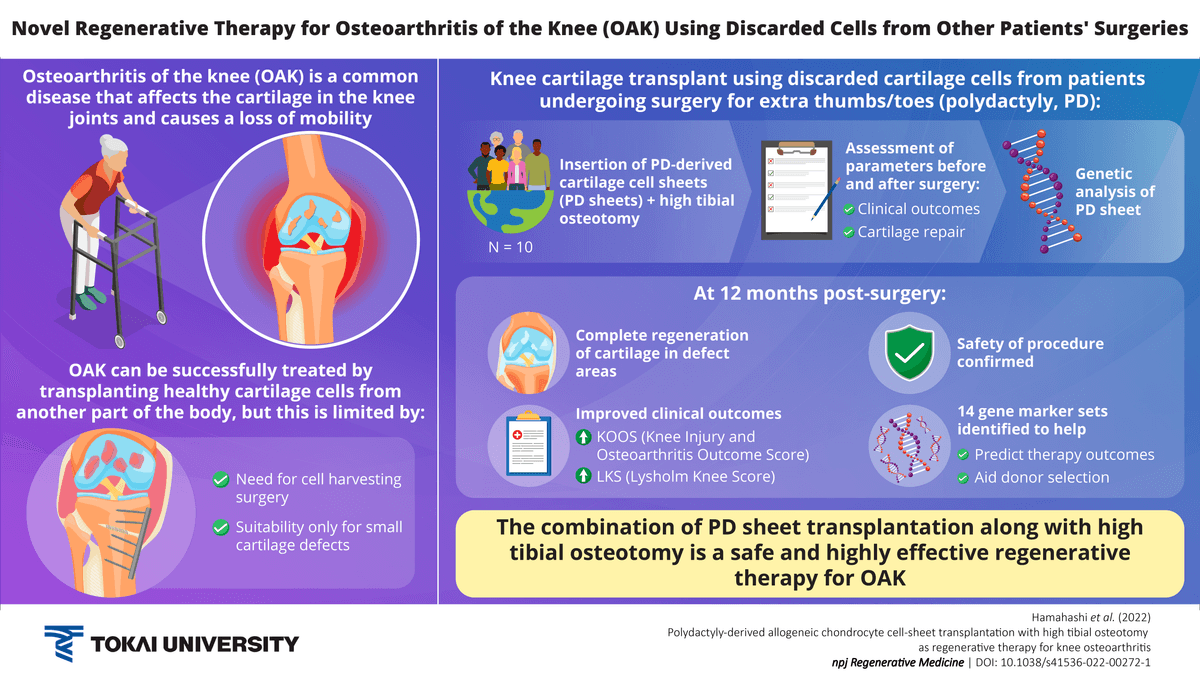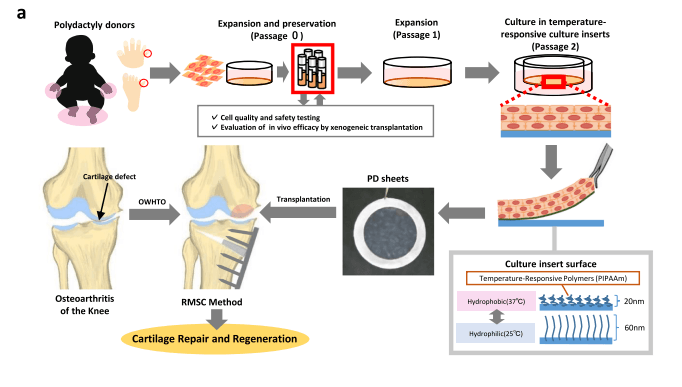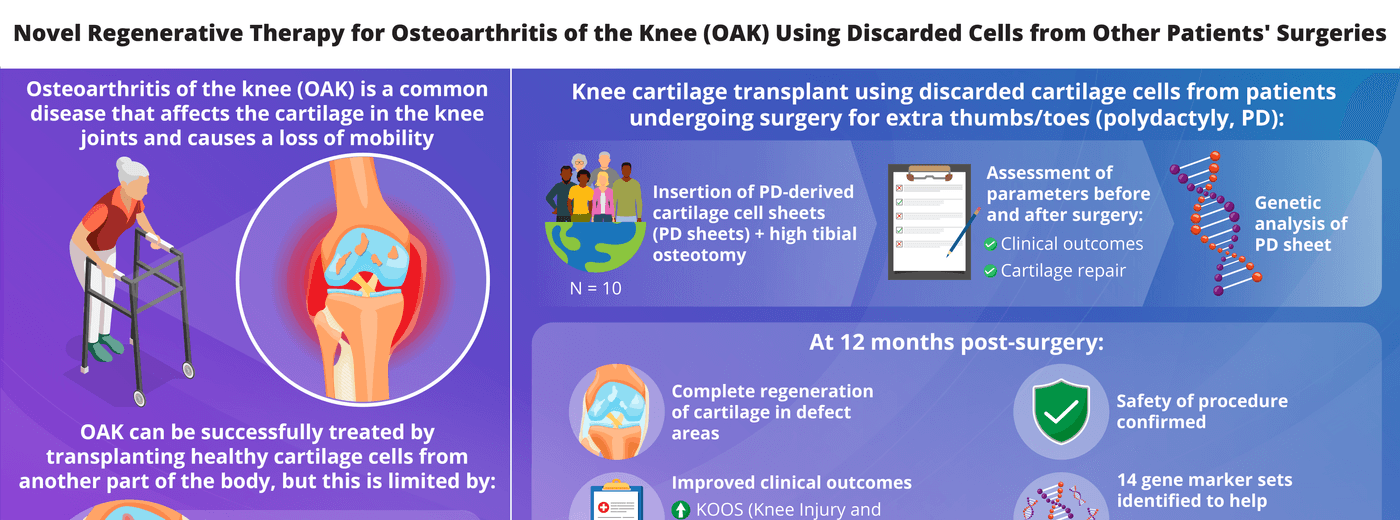A Novel Treatment for Osteoarthritis Using Discarded Cells from Other Patients’ Surgeries
The regenerative treatment involves the transplantation of cartilage cell sheets made from the cells of patients undergoing surgery for the resection of extra fingers/toes.
Osteoarthritis of the knee (OAK) is a common condition, in which the cartilage in the knees is worn down. But while there are many treatments for OAK, most are not effective in regenerating cartilage. To address this, researchers from Japan have recently proposed a novel approach in which cartilage sheets made from discarded tissue from donor patients are transplanted into patients with OAK. The treatment is highly effective in regenerating lost cartilage.
Osteoarthritis is a painful, degenerative condition that primarily affects the joints. One of the most prevalent forms of osteoarthritis is arthritis of the knee (OAK), which is not only a painful condition, but also affects the mobility of patients and their overall quality of life. While there are many options to treat OAK, ranging from knee replacement to non-invasive therapies, in recent years, regenerative therapy has come to the forefront due to its ability to restore lost cartilage. Of these, allogeneic cell therapies, i.e., therapies using cells from donors, offer the most advantages. This is for two primary reasons. First, donor cells can be obtained in a manner that is non-invasive to the patient. Second, there are no limits to the amount of donor cells that can be obtained, and thus, no limits to the size of cartilage defects that they can address. However, existing allogeneic therapies are not entirely effective in regenerating cartilage in patients with OAK.
Recently, a team of researchers from Japan, led by Prof. Masato Sato from Tokai University, has developed a novel regenerative therapy for treating patients with OAK. Describing their therapy, Prof. Sato says, “The novel therapy uses discarded cartilage cells, or chondrocytes, from patients undergoing surgery for polydactyly (a condition in which patients have more than five fingers/toes). These chondrocytes are used to develop cell sheets. These so called polydactyly-derived chondrocyte cell sheets, or PD sheets, are then transplanted into patients during a surgical procedure called open wedge high tibial osteotomy (OWHTO), which is commonly used to treat OAK.” The research team included Kosuke Hamahashi and Tadashi Akamatsu of Tokai University, Hidenori Akutsu of the National Center for Child Health and Development, and Teruo Okano of the University of Utah. The study has been published in npj Regenerative Medicine.
For their study, the authors first prepared PD sheets and placed them into 10 patients with OAK. They assessed the state of the patients’ cartilage, as well as their clinical characteristics, both before the surgery, and at 12 months after the surgery. They found that all 10 patients had complete regeneration of cartilage in the defect areas at 12 months post-surgery. The cartilage was found to be normal, and typical of hyaline cartilage, i.e., the normal cartilage that is found in the knees. All patients, moreover, exhibited improved clinical outcomes, as evidenced by the commonly used Knee Injury and Osteoarthritis Score (KOOS) and Lysholm Knee Score (LKS). Importantly, no adverse effects were reported by the patients, indicating that the procedure is not only effective, but safe as well.
The researchers further performed genetic analyses on the PD sheets and identified 14 gene marker sets that can help to predict therapy outcomes, as well as aid in the selection of an appropriate donor. “In a nutshell, this therapy has the potential to allow people to walk their entire lives on their own knees, without requiring artificial joints. Cells that would otherwise be discarded during surgery can be used to improve other people’s lives instead,” concludes Prof. Sato.
Based on the novel regenerative treatment for OAK is both safe and effective. We look forward to it be implemented to better the lives of patients with this debilitating condition.
Reference

Image caption:The novel therapy transplants cartilage cell sheets derived from patients undergoing surgery for polydactyly (an excess of fingers or toes) into patients with knee osteoarthritis
Image credit: Masato Sato of Tokai University
License: Original content
Usage restrictions: Not to be reused without permission

Image caption:First, cells from donors with polydactyly are obtained. These are then processed into cartilage sheets (PD sheets) in a three-step process. Finally, they are transplanted into patients with knee osteoarthritis during open wedge high tibial osteotomy (OWHTO) surgery.
Image credit: npj Regenerative Medicine https://www.nature.com/articles/s41536-022-00272-1
License:CC BY 4.0
About Professor Masato Sato
Masato Sato is a professor at the Department of Orthopedic Surgery, Tokai University School of Medicine. He holds a medical degree from the National Defense Medical College. He joined Tokai University as an assistant professor in 2003. He is also a director of the Center for Musculoskeletal Innovative Research and Advancement. His primary areas of interest include tissue engineering, cell-sheet technology, and non-invasive mechanical evaluation. He has more than 300 research papers to his credit.
